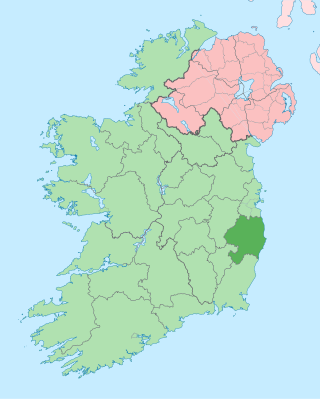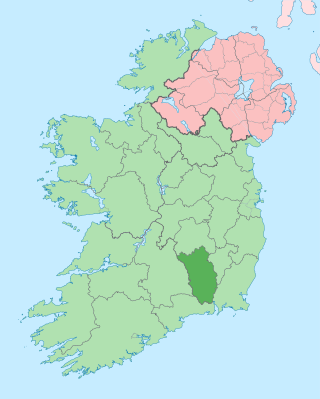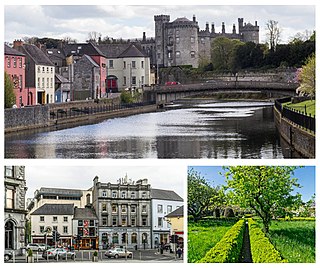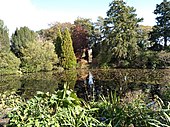
County Wicklow is a county in Ireland. The last of the traditional 32 counties, having been formed as late as 1606, it is part of the Eastern and Midland Region and the province of Leinster. It is bordered by the Irish Sea to the east and the counties of Wexford to the south, Carlow to the southwest, Kildare to the west, and South Dublin and Dún Laoghaire–Rathdown to the north.

Rhododendron is a very large genus of about 1,024 species of woody plants in the heath family (Ericaceae). They can be either evergreen or deciduous. Most species are native to eastern Asia and the Himalayan region, but smaller numbers occur elsewhere in Asia, and in North America, Europe and Australia.

County Kilkenny is a county in Ireland. It is in the province of Leinster and is part of the Southern Region. It is named after the city of Kilkenny. Kilkenny County Council is the local authority for the county. At the 2022 census the population of the county was 103,685. The county was based on the historic Gaelic kingdom of Ossory (Osraighe), which was coterminous with the Diocese of Ossory.

Kilkenny is a city in County Kilkenny, Ireland. It is located in the South-East Region and in the province of Leinster. It is built on both banks of the River Nore. The 2022 census gave the population of Kilkenny as 27,184, the thirteenth-largest urban center in Ireland.

Altamont is a city in Effingham County, Illinois, United States. The population was 2,216 at the 2020 census. Altamont is part of the Effingham, Illinois Micropolitan Statistical Area.

County Carlow is a county located in the Southern Region of Ireland, within the province of Leinster. Carlow is the second smallest and the third least populous of Ireland's 32 traditional counties. Carlow County Council is the governing local authority.

County Wexford is a county in Ireland. It is in the province of Leinster and is part of the Southern Region. Named after the town of Wexford, it was based on the historic Gaelic territory of Hy Kinsella, whose capital was Ferns. Wexford County Council is the local authority for the county. The population of the county was 163,527 at the 2022 census.

Athy is a market town at the meeting of the River Barrow and the Grand Canal in south-west County Kildare, Ireland, 72 kilometres southwest of Dublin. A population of 11,035 made it the sixth largest town in Kildare and the 45th largest in the Republic of Ireland, a growth of 82% since the 2002 census.

Ballon is a village, civil parish and townland in County Carlow, Ireland. It is located on the N80 road near Carlow town.

Borris is a village on the River Barrow, in County Carlow, Ireland. It lies on the R702 regional road.

Kilcullen, formally Kilcullen Bridge, is a small town on the River Liffey in County Kildare, Ireland. Its population of 3,815 at the 2022 census made it the 13th largest settlement in County Kildare. From 2002 to 2011, it was one of the fastest growing towns in the county, doubling its population from 1,483 to 3,473. It is situated primarily in the Barony of Kilcullen, with a part in the Barony of Naas South, and subsidiary areas include Logstown, Harristown, Carnalway and Brannockstown, Gilltown, Nicholastown, and Castlemartin.

Carlow is the county town of County Carlow, in the south-east of Ireland, 84 km (52 mi) from Dublin. At the 2022 census, it had a population of 27,351, the twelfth-largest urban center in Ireland.

Lisnavagh Estate is an estate house which lies outside the village of Rathvilly in County Carlow, Ireland. Lisnavagh is the family seat of the McClintock-Bunbury family, Barons Rathdonnell. A plaque in the present house states that the original house at Lisnavagh was built by William Bunbury in 1696. A map from the 1840 Ordnance Survey shows this in the parklands below the current house, with some modest farm buildings close by. The 1840 map also shows "Foundations of House" to the northwest, near the top of the hill, which is where a new house was planned but never completed. The new house was ultimately built nearer to the old house.

Paris Mountain State Park is a state park in the U.S. state of South Carolina, located five miles (8 km) north of Greenville. Activities available in the 1,540-acre (6 km2) park include hiking, biking, swimming and picnicking. The 13-acre (52,609 m2) Lake Placid offers swimming and fishing. Canoes, kayaks, and pedal boats are seasonally available for rental; private boats are not permitted. Camping is allowed and campsites range from rustic, back country sites to paved sites with water and electricity hook-ups. The park's Civilian Conservation Corps (CCC) structures, including the Camp Buckhorn lodge, are listed on the National Register of Historic Places. m.

Duckett's Grove(Irish: Garrán Duckett) is a ruined 19th-century great house and former estate in County Carlow, Ireland. Belonging to the Duckett family, the house was formerly the focal point of a 12,000-acre (49 km2) estate, and dominated the local landscape of the area for more than two centuries. The interior of the house was destroyed by a major fire in the 1930s and is now inaccessible. The surrounding gardens, including two inter-connecting walled gardens, are now managed by Carlow County Council and open as a public park.

Mount Congreve is an 18th-century Georgian estate and mansion situated near the village of Kilmeaden in County Waterford, Ireland. The architect was John Roberts, a Waterford-based architect who subsequently designed and built most of the 18th-century public buildings in Waterford, including both cathedrals. The House is situated close to the Southern bank of the River Suir approximately 7 kilometres from Waterford City. It overlooks County Kilkenny to the North.

The South Leinster Way is a long-distance trail in Ireland. It is 104 kilometres long and begins in Kildavin, County Carlow and runs through County Kilkenny before ending in Carrick-on-Suir, County Tipperary. It is typically completed in five days. It is designated as a National Waymarked Trail by the National Trails Office of the Irish Sports Council and is jointly managed by Carlow County Council, Kilkenny County Council, Tipperary County Council, Carlow Local Sports Partnership, Kilkenny Trails and Coillte. It was opened on 30 November 1985 by Donal Creed, Minister of State for Sport.

Killoughternane Church is a 10th-century Celtic Christian church located in County Carlow, Ireland. It was built on the remains of a timber church said to have been built by Fortiarnán in the 5th century AD.























